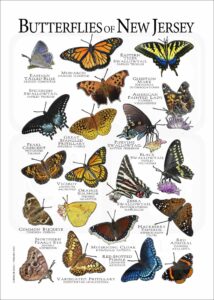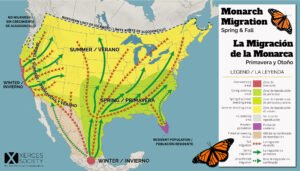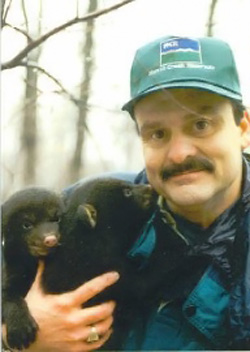MCR Monthly Newsletter
What’s Hatchn’ing at Merrill Creek Reservoir with Ranger Rich

About the Author: Richard Dansen Sr.
Rich has a bachelor’s degree in Environmental Science with a concentration in zoology and wildlife management. Rich has been with Merrill Creek Reservoir since 1995 where he teaches environmental education.
You can find Rich each weekend at the MCR visitors center talking about the wonderful wildlife and habitats of MCR. Stop by to say hi!
“In writing this monthly newsletter, I hope to inform and educate readers about some of the wonderful and fascinating events going on in nature at Merrill Creek Reservoir each month. Enjoy!”
– Ranger Rich
July
This month beautiful butterflies add more color to nature’s tapestry evident in Merrill Creek’s fields and meadows.
CATERPILLARS (Nature’s eating machines!)
 Caterpillars have mouthparts designed for chewing and eating leaves….. After hatching from an egg, young caterpillars eat ravenously and bulk up for one of nature’s most amazing transformations…METAMORPHOSIS!
Caterpillars have mouthparts designed for chewing and eating leaves….. After hatching from an egg, young caterpillars eat ravenously and bulk up for one of nature’s most amazing transformations…METAMORPHOSIS!
Once sufficient nourishment has been consumed the caterpillar forms a pupa (a.k.a. chrysalis) where it pupates into a butterfly. This is where something amazing happens! During its transformation, the caterpillar relinquishes its eating mouthparts in exchange for reproductive organs. Now emerging as male or female!
Do you know it is virtually impossible to tell the sex of a caterpillar? Most species don’t have sex-specific features until they become butterflies. The main purpose of the butterfly phase now is to find a mate and mate as quickly as possible! Now life is short! In this strategy the adults in no way compete with the juveniles for food resources.
Butterflies can be seen puddling on moist concrete or mud puddles for moisture, salt, and minerals, also, visiting flowers and sipping sweet nectar for a boost of energy until a mate is found. Females give off a pheromone that males can locate with their antennae. They mate…. the female deposits eggs on the host plant preferred by the next generation to eat and the cycle starts over.
For example: Monarch caterpillars feed on the very bitter sap of the milkweed plant. This bitter sap makes the adult butterfly taste bad, so birds and other predators avoid eating them.
According to the Xerces Society, “Every year as it gets colder, North American monarch butterflies migrate south between August and October. Monarchs that spend the summer breeding west of the Rocky Mountains tend to migrate to California coasts, while monarchs breeding further east migrate to Mexico to the oyamel fir forests at an elevation of 2,400 to 3,600 meters (nearly 2 miles above sea level). A migrating monarch can fly up to 2,500 or sometimes even 3,000 total miles before reaching its destination. A monarch can travel over 100 miles in a single day with the right conditions. These butterflies coast on air currents to move quickly and conserve energy. They often fly at elevations where we can’t even see them from the ground, at 800 to 1,200 feet high. Monarchs that migrate north in spring will breed and pass away far before their descendants are ready to migrate south again. None of the monarchs on the fall migration path have ever been to their destination before, and yet they know exactly where to go. Scientists believe they use cues like magnetism and sunlight to navigate directionally, but the rest is still a mystery. The monarchs that migrate south are the last generation born each year, and they live up to 8 months longer than their ancestors from earlier in the summer. A typical monarch life span is 2 to 6 weeks. Migrating monarchs live up to 9 months, with their lifetimes spent migrating south, sticking out the winter. As warm temperatures and lengthening days arrive, the migratory generation of monarchs finishes the development they halted prior to their migration. They become reproductive, breed and lay the eggs of the new generation. This starts the journey back north. Unlike the generation before them, who made a one-generation journey south, successive generations make the journey north. Generation 1 monarchs are the offspring of the monarchs who overwintered in Mexico. Each successive generation travels farther north. It will take 3-4 generations to reach the northern United States and Canada.”
the summer breeding west of the Rocky Mountains tend to migrate to California coasts, while monarchs breeding further east migrate to Mexico to the oyamel fir forests at an elevation of 2,400 to 3,600 meters (nearly 2 miles above sea level). A migrating monarch can fly up to 2,500 or sometimes even 3,000 total miles before reaching its destination. A monarch can travel over 100 miles in a single day with the right conditions. These butterflies coast on air currents to move quickly and conserve energy. They often fly at elevations where we can’t even see them from the ground, at 800 to 1,200 feet high. Monarchs that migrate north in spring will breed and pass away far before their descendants are ready to migrate south again. None of the monarchs on the fall migration path have ever been to their destination before, and yet they know exactly where to go. Scientists believe they use cues like magnetism and sunlight to navigate directionally, but the rest is still a mystery. The monarchs that migrate south are the last generation born each year, and they live up to 8 months longer than their ancestors from earlier in the summer. A typical monarch life span is 2 to 6 weeks. Migrating monarchs live up to 9 months, with their lifetimes spent migrating south, sticking out the winter. As warm temperatures and lengthening days arrive, the migratory generation of monarchs finishes the development they halted prior to their migration. They become reproductive, breed and lay the eggs of the new generation. This starts the journey back north. Unlike the generation before them, who made a one-generation journey south, successive generations make the journey north. Generation 1 monarchs are the offspring of the monarchs who overwintered in Mexico. Each successive generation travels farther north. It will take 3-4 generations to reach the northern United States and Canada.”
Project Monarch watch is an education, conservation, and research program based at the University of Kansas that focuses on the monarch butterfly, its habitat, and its spectacular fall migration. Participating in Project monarch watch. Merrill Creek tagged 2 butterflies that successfully made it 2,080 miles from Harmony NJ!
Get out and enjoy nature!
Remember: Take pictures …leave only footprints!
Rich

